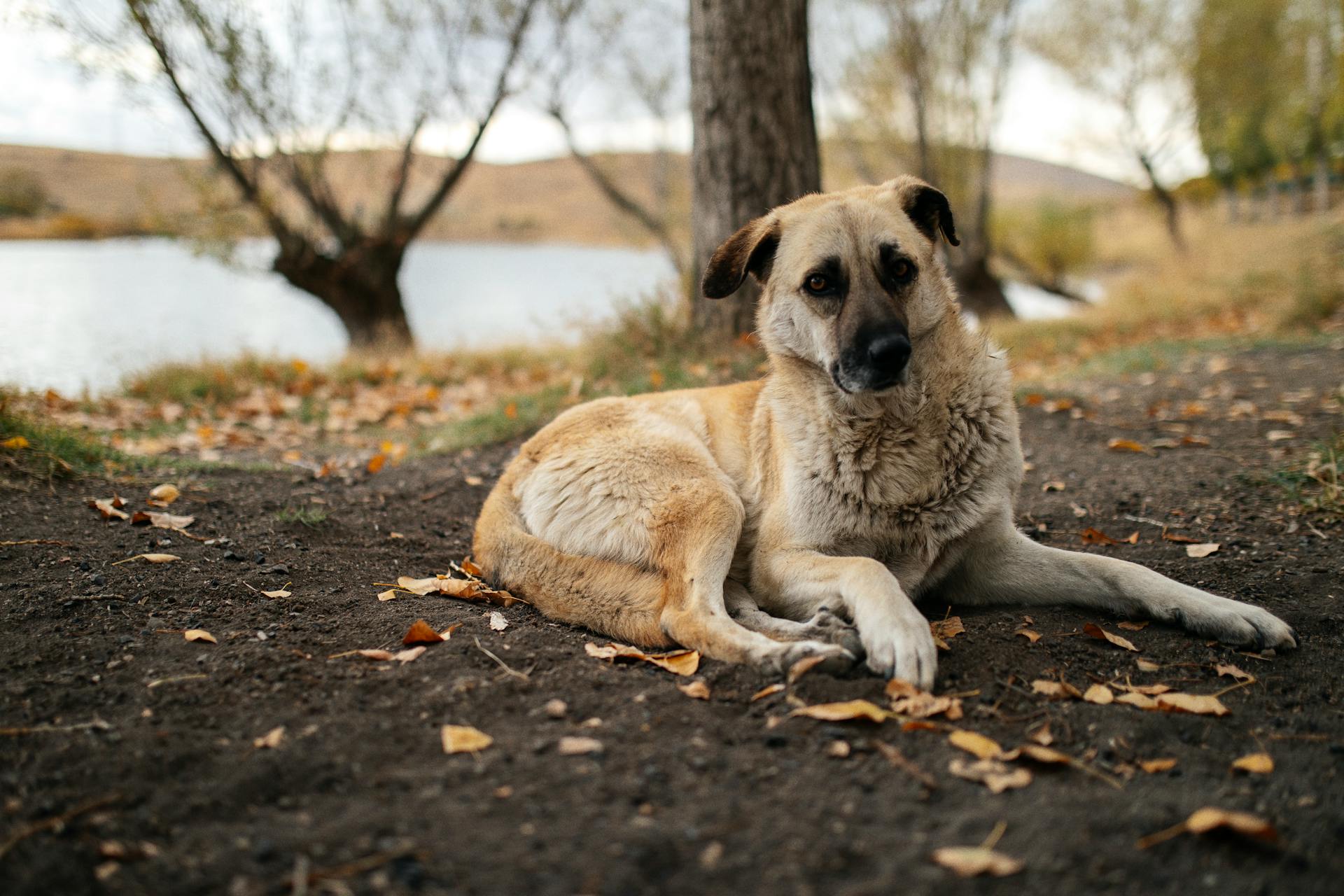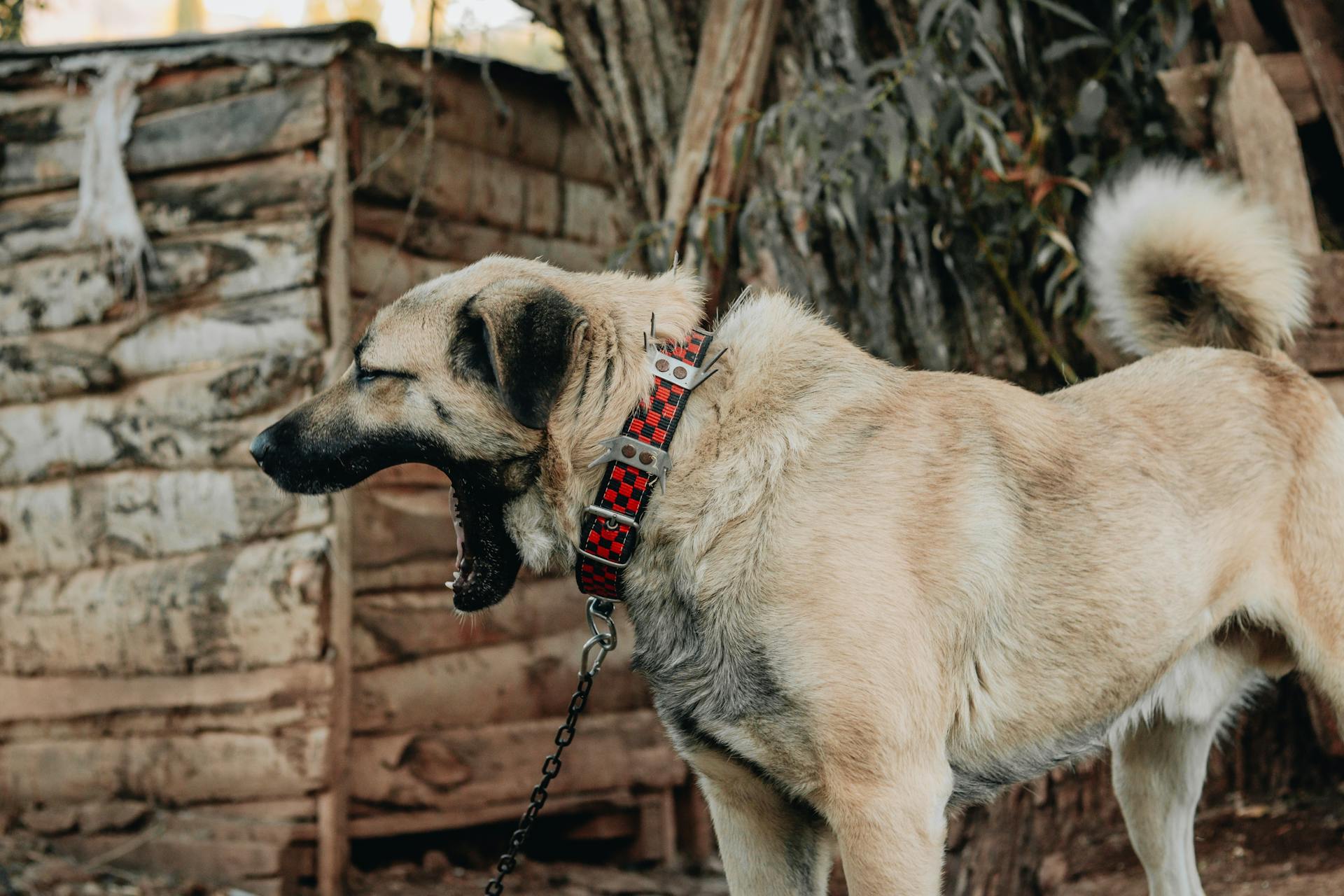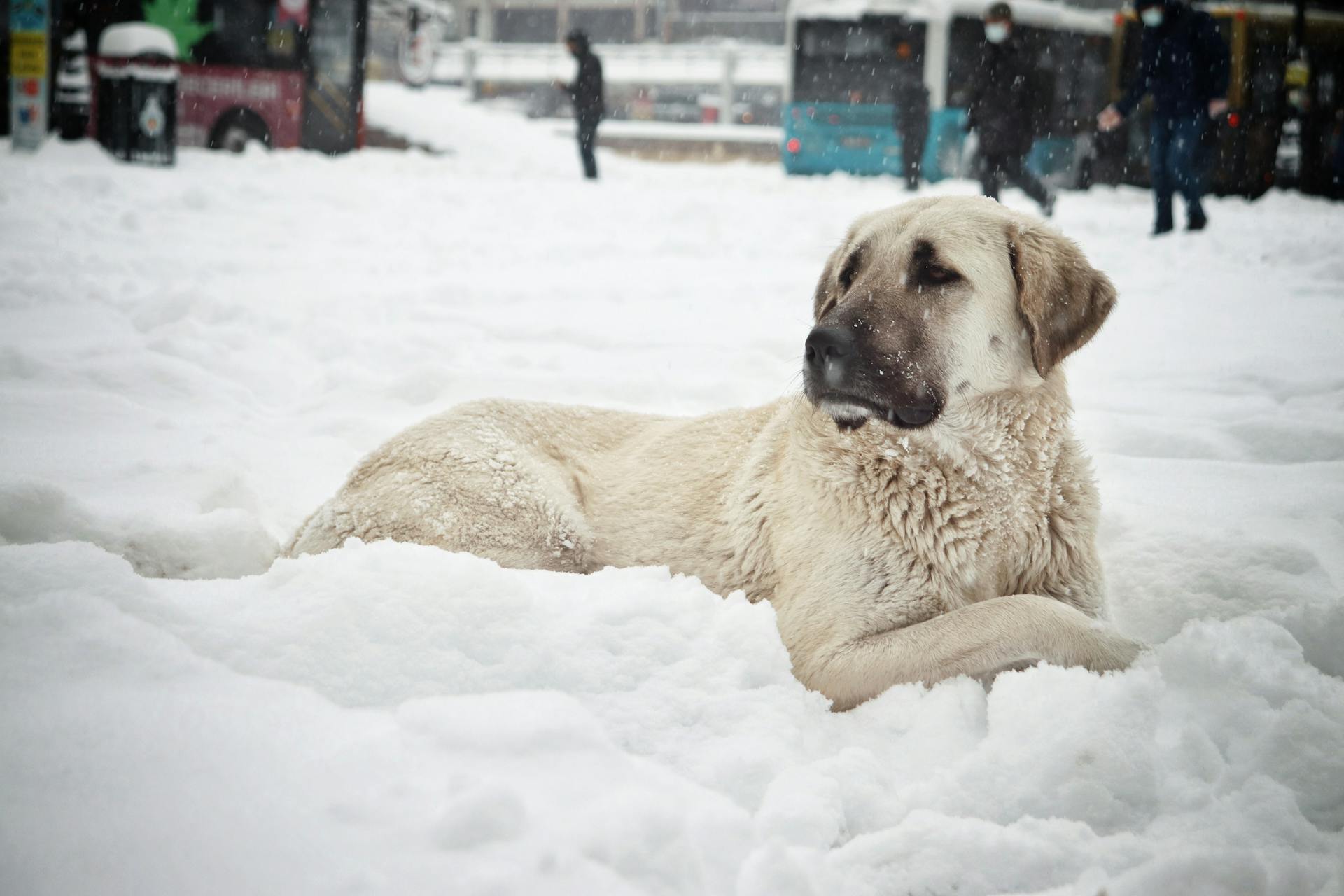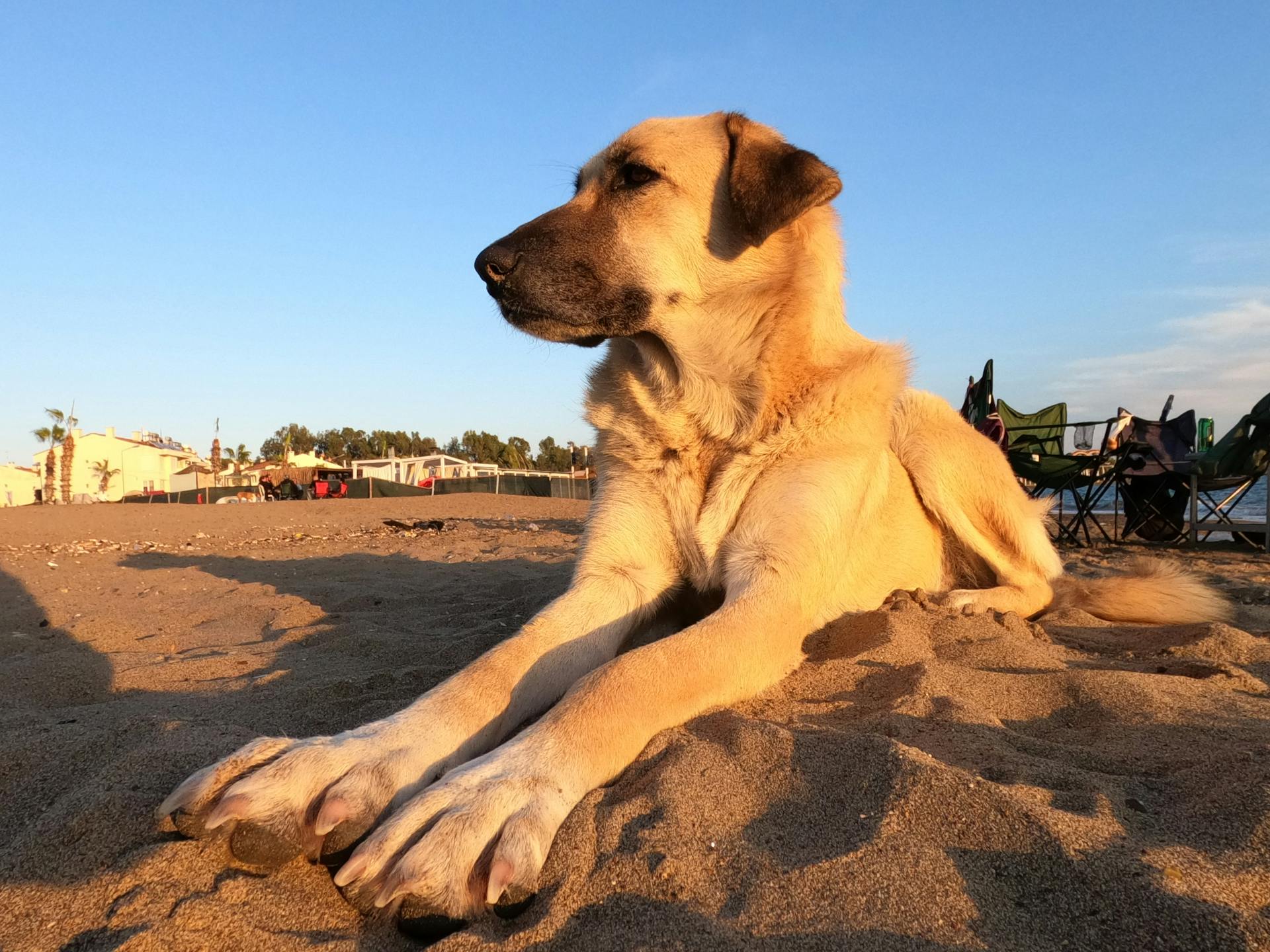
The Kangal Turco Dog is a beloved breed known for its loyalty and protective nature.
Originating from Turkey, this ancient breed has been guarding livestock and families for centuries.
One of the most distinctive features of the Kangal Turco Dog is its size, with adults typically weighing between 80-120 pounds.
This breed is also known for its short, dense coat that requires minimal grooming.
Care and Maintenance
The Turkish Kangal Dog requires regular grooming, but it's not a high-maintenance task. Brush your Kangal through every few days to prevent matting and tangling.
A full bath is a major job for a dog of this size, so it's essential to habituate your puppy to this process from an early age.
Did You Know?
The Turkish Kangal Dog is a guardian breed with a rich history. It has been used to guard sheep from predators, but in Namibia, a more surprising use case has been implemented.
In 1994, the Cheetah Conservation Fund started giving 300 Kangal dogs to farmers to protect their livestock from cheetah attacks. This initiative has been extremely effective in reducing the number of cheetahs killed by farmers.
Farmers were previously killing any cheetah seen near the farm, but now they only eradicate those known to have killed livestock. This change has led to a significant reduction in livestock losses to cheetah, with a cut of around 80% since the introduction of the Kangal dogs.
Curious to learn more? Check out: Dog Killed
History
The Kangal Turco dog has a rich history that dates back centuries. It was developed as a livestock guardian breed in Central Anatolia, where it played a crucial role in protecting flocks from predators.
The breed's name is derived from the town of Kangal in the Sivas Province of Turkey. Its origins are thought to be linked to nomadic Turks who brought the breed from Central Asia.
The Kangal has been used by shepherds for protection against wolves and other predators for centuries. This traditional working breed has been an essential part of Turkish culture.
A DNA study found that the dogs of Kazakhstan, Uzbekistan, Tajikistan, and Afghanistan are genetically closest to Kangal dogs. This suggests that the breed may have been brought from Central Asia by the nomadic Turks.
The Kangal was definitively accepted by the Fédération Cynologique Internationale in 1989.
Recommended read: Ovcharka Alabai
Characteristics and Use
The Kangal Turco dog is a remarkable breed with unique characteristics that make it well-suited for its original purpose as a livestock guardian dog. They usually stand between 72 and 78 cm (28 and 31 in) at the withers, with a tolerance of 2 centimeters either way for both sexes.
Their coat is a key feature, providing insulation against extreme temperatures and repelling water and snow. This allows them to regulate their core temperature efficiently. The coat is also dense enough to repel rupture from wolf bites.
Here are some key characteristics of the Kangal Turco dog:
- Originates in Turkey
- FCI breeds
- Livestock guardian dogs
As a guardian dog, they can reach speeds of up to 56 km/h (35 mph), making them surprisingly agile for their size.
Personality
The Kangal's personality is a unique blend of power and calmness. They can be intimidating to strangers, but with proper socialization, they can be gentle and loving.
They are independent thinkers, capable of making decisions without human input, which can make training a challenge.

Their large size and strong bite force can be intimidating, but with common sense and proper training, they can be a loving companion.
Kangals are not the most affectionate dogs, but they are patient and loyal to their humans. They can be territorial and protective of their family, making them good guard dogs.
As long as you watch your kids closely, they can be a safe and loving presence in your home. They are generally not aggressive, but they will defend their family if they sense a threat.
Their calm and controlled nature makes them a great addition to a family with children and other pets.
Training Turkish Dogs
Training a Turkish Kangal dog requires a strong bond built on kindness, consistency, and patience. They can be slow to mature, but with the right approach, they can become intelligent and independent companions.
Pay attention to early socialization, as this is crucial for their development. Teach them a reliable recall, retrieve, and down to establish a solid foundation.
Kangals are not dogs to be bullied or manhandled into submission. This approach will only lead to frustration and potentially harm the dog.
Management is key when dealing with a breed of this size, so be prepared to take control and make decisions to ensure their safety and well-being. They can weigh up to 150 pounds, after all.
With proper training and socialization, Kangals can be loyal and gentle with their family, making them great companions.
Characteristics
The Kangal Shepherd Dog is a remarkable breed with some impressive characteristics. They typically stand between 72 and 78 cm tall at the withers, with bitches slightly smaller at 65 to 73 cm.
Their build is unique for a mastiff breed, allowing for greater speed and agility than larger dogs. In fact, they can reach speeds of up to 56 km/h.
Their coat is a key feature, providing insulation against extreme temperatures and repelling water and snow. The outer-layer is dense enough to protect against wolf bites.
Here are some interesting characteristics of the Kangal Shepherd Dog:
- Originates in Turkey
- Recognized by the FCI
- Used as livestock guardian dogs
Use

The Kangal's use is quite impressive. They're a traditional flock guardian dog, kept with flocks of sheep to fend off wolves and other predators.
Their protective instincts are so strong that they've been exported to African countries like Namibia, Kenya, and Tanzania, where they successfully protect local flocks from cheetahs. This has contributed to the conservation of endangered cheetah populations, which is a remarkable outcome.
Health and Safety
The Kangal Turco Dog is a massive breed, but don't worry, they're naturally protective of their families, not aggressive.
Their thick coats are designed to withstand extreme temperatures in Turkey's harsh climate, keeping them warm in winter and cool in summer.
Kangal Turco Dogs are generally healthy, but like all breeds, they can be prone to certain health issues, including hip dysplasia and eye problems.
They're also naturally good swimmers, thanks to their water-resistant coats and webbed feet.
Their calm and gentle nature makes them a great breed for families with children, but early socialization is key to ensure they grow into well-adjusted adult dogs.
Regular exercise is essential to keep Kangal Turco Dogs happy and healthy, but they don't require as much exercise as some other breeds, making them a great choice for busy owners.
Size and Space

The Kangal Turco dog is a large breed that requires plenty of space to roam and exercise. They can grow up to 34 inches tall at the shoulder and weigh between 90 and 150 pounds.
Males are typically taller than females, with a height range of 29 to 33 inches, while females stand at 27 to 31 inches. Their weight range is also sex-dependent, with males weighing 110 to 145 pounds and females weighing 90 to 130 pounds.
A large yard with a secure fence is recommended to keep them safe and happy, and regular exercise is essential to keep them mentally and physically stimulated. This can be achieved through walks, dog daycare, or other forms of physical activity.
Sizes of Full-Grown Dogs
Full-grown Kangal dogs can reach an impressive size, with males typically standing between 28 to 34 inches at the shoulder.
Their weight range is generally between 90 and 150 pounds, qualifying them as a large dog breed.

Males are typically 29 to 33 inches in height, while females are typically 27 to 31 inches.
Male Kangals weigh about 110 to 145 pounds, and females weigh anywhere between 90 to 130 pounds.
Kangals are fully mature by 1 and a half years old, but gain weight until they are around 2 to 3 years old.
A balanced and appropriate diet during growth stages is crucial for reaching their full genetic potential, and regular checkups and vaccinations can help maintain their overall health.
The Anatolian shepherd, a sub-breed of the Kangal dog, is slightly smaller and lives about 10 to 13 years, compared to the Kangal's average lifespan of 12 to 15 years.
You might enjoy: Bull Terrier Then and Now
Dog Space Requirements
A large yard with a secure fence is recommended for dogs that need plenty of exercise, like the Kangal.
The Kangal's large size means it's not well-suited for apartment living.
Regular walks or dog daycare is essential to keep them mentally and physically stimulated.
A nationwide dog daycare facility, Dogtopia, agrees that plenty of exercise is crucial for the Kangal's well-being.
For your interest: Is Dog Daycare Good for Dogs
Frequently Asked Questions
Is a Turkish Kangal a good family dog?
Yes, the Turkish Kangal is a loyal and protective breed that makes a great family dog, especially for families with children and pets. They are gentle and loving, yet trustworthy guardians of their pack.
Is Kangal the strongest dog in the world?
Kangal dogs have the strongest jaws in the world, with a bite force of 734 psi. Their powerful jaws make them well-suited for protecting livestock from predators.
Is Kangal stronger than Pitbull?
Yes, the Kangal is more than twice as strong as the average Pitbull. Read on to learn more about the strength of different dog breeds and their unique characteristics.
How much does a Kangal Dog cost?
A Kangal Dog typically costs between $800 to $5,000, depending on the breeder and bloodline. Prices vary, so it's best to research and contact a reputable breeder for a more accurate estimate.
Sources
- https://www.purina.co.uk/find-a-pet/dog-breeds/turkish-kangal-dog
- https://en.wikipedia.org/wiki/Kangal_Shepherd_Dog
- https://medium.com/@omer.u.ozer/why-kangals-are-the-best-dogs-and-why-you-should-not-get-one-fd941e1f0500
- https://www.dogster.com/dog-breeds/kangal-bite-force
- https://www.forbes.com/advisor/pet-insurance/pet-care/kangal-dog-size/
Featured Images: pexels.com


